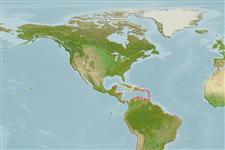Bivalvia |
Venerida |
Veneridae
Environment: milieu / climate zone / depth range / distribution range
Ecology
Benthic; depth range 0 - 2 m (Ref. 83435). Tropical, preferred 27°C (Ref. 107945); 22°N - 29°S, 89°W - 14°W
Western Atlantic: from Guatemala to Cuba in the Caribbean, east to Ascension Island and south to Santa Catarina Brazil.
Length at first maturity / Size / Weight / Age
Maturity: Lm ? range ? - ? cm Max length : 3.4 cm DL male/unsexed; (Ref. 83435); common length : 3.8 cm TL male/unsexed; (Ref. 344)
Shell heavy, thick, inflated, triangular. Shell surface umbones central and prominent. Hinge with 3 cardinal teeth, with smaller secondary teeth present. Lateral tooth in left valve large. Lunula large, escutcheon absent. Periostracum like varnish. Colour: whitish with brown tinges and rays.
Minimum depth from Ref. 104365. Lives in sand, from the intertidal to very shallow subtidal (Refs. 344, 114796). Shallowly buried in sandy bottoms (Ref. 114795). Abundant near river mouths where organic matter and terrigenous particulates accumulate (Ref. 114796). Suspension feeder (Ref. 78149).
Life cycle and mating behavior
Maturity | Reproduction | Spawning | Eggs | Fecundity | Larvae
Members of the class Bivalvia are mostly gonochoric, some are protandric hermaphrodites. Life cycle: Embryos develop into free-swimming trocophore larvae, succeeded by the bivalve veliger, resembling a miniature clam.
Leal, J.H. 2003 Bivalves. p. 25-98. In Carpenter, K.E. (ed.). The living marine resources of the Western Central Atlantic. Volume 1: Introduction, molluscs, crustaceans, hagfishes, sharks, batoid fishes, and chimaeras. FAO Species Identification Guide for Fishery Purposes and American Society of Ichthyologists and Herpetologists Special Publication No. 5. 1600p. (Ref. 344)
IUCN Red List Status
(Ref. 130435: Version 2025-1)
CITES status (Ref. 108899)
Not Evaluated
Not Evaluated
Threat to humans
Human uses
Fisheries: commercial
FAO - Fisheries: landings | FishSource | Sea Around Us
Tools
More information
Trophic EcologyFood items (preys)
Diet composition
Food consumption
Predators
Population dynamicsGrowthMax. ages / sizesLength-weight rel.Length-length rel.Length-frequenciesMass conversionAbundance Life cycleReproductionMaturityFecunditySpawningEggsEgg developmentLarvae PhysiologyOxygen consumption
Human RelatedStamps, coins, misc.
Internet sources
Estimates based on models
Preferred temperature
(Ref.
115969): 27.2 - 28.4, mean 27.6 (based on 250 cells).
Prior r = 1.18, 95% CL = 0.78 - 1.77, Based on 1 data-limited stock assessment.
Fishing Vulnerability
Low vulnerability (10 of 100).
Climate Vulnerability
High to very high vulnerability (71 of 100).
Nutrients : Calcium = 149 [71, 228] mg/100g; Iron = 8.53 [1.95, 15.11] mg/100g; Protein = 9.88 [8.64, 11.12] %; Omega3 = 0.313 [0.202, 0.423] g/100g; Selenium = 61 [50, 72] μg/100g; VitaminA = 0 μg/100g; Zinc = 2.04 [0.56, 3.51] mg/100g (wet weight); based on
nutrient studies.
